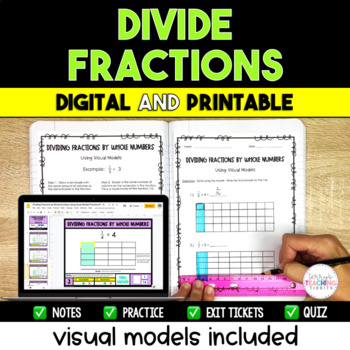Divide Fractions with Visual Models Included - Digital & Printable
- Zip
- Google Apps™

What educators are saying
Products in this Bundle (2)
Also included in
- Use visual models along with the standard algorithm and area models to quickly and effectively teach your students how to add, subtract, multiply, and divide fractions and mixed numbers with this comprehensive printable & digital resource pack. With 21 mini-lessons, (6 adding and subtracting fraPrice $52.00Original Price $70.00Save $18.00
- Teach your students every single 5th grade math standard (Common Core and the NEW Georgia Mathematics Standards) for the entire year with this comprehensive printable & digital resource pack. It has everything you need to teach each skill, including notes, tutorial videos, practice, exit ticketPrice $225.00Original Price $342.00Save $117.00
Description
Use visual models along with the standard algorithm to quickly and effectively teach your students how to divide fractions with this comprehensive digital and printable resource pack.
Using visual models, students will have a more hands-on approach to “see” what it looks like when dividing unit fractions by whole numbers and dividing whole numbers by unit fractions in addition to using the standard algorithm. It’s great for kinesthetic learners as well as students that may struggle with memorizing algorithms.
A mini-lesson on dividing fractions by fractions (6th grade standard 6.NS.1) is also provided and can be used with students who quickly master dividing with unit fractions. Great for differentiation!
This resource is complete, comprehensive, and easy to follow with a clear format. It is low-prep, easy to assign to a sub, and contains engaging printable activities and digital versions for use with Google Classroom. If your students are struggling conceptually, this resource is for you!
Supports Common Core Standards (CCSS): 5.NF.7, 5.NF.7a, 5.NF.7b, 5.NF.7c, 6.NS.1
This resource is included in a year-long 5th Grade Math Curriculum Bundle.
Download the preview file to see more details.
This Bundle Includes:
⭐️ Divide Fractions (Printable)
The Mini-Lessons Included:
- Fraction Notes Pages for Simplifying Fractions and Converting Improper Fractions to Mixed Numbers
- Divide Unit Fractions by Whole Numbers with Visual Models
- Divide Whole Numbers by Unit Fractions with Visual Models
- Divide Fractions Using the Standard Algorithm
- Divide Fractions with Word Problems
What You’ll Get in EACH of the mini-lessons:
- Detailed Notes
- Sample Problems
- 1-2 Practice Pages
- 2 Exit Tickets
You’ll Also Get:
- Quiz
***All Digital activities are in Google Slides and Google Forms***
How Can You Use This?
Introduce each skill with the detailed set of notes and sample problems. I suggest doing this in a whole group setting and displaying the PDF or pulling the slides up on a Smartboard if you’re in person or share the screen online if you’re teaching virtually.
Gradually release students to practice independently using the practice pages or slides activities. Check for understanding and mastery after teaching each skill using the exit tickets.
When all skills have been taught, assess with the final quiz when you feel students are ready.
WHAT OTHER TEACHERS ARE SAYING…
⭐️⭐️⭐️⭐️⭐️ This resource is outstanding! I love the visuals and the little tutorial video you give too. Honestly, I threw out all of my old "stuff" and I am using this instead. It has been great with my special needs students. It saved me HOURS of prep work transforming my old lessons into updated, distance learning lessons. Thank you! - Dawn C.
⭐️⭐️⭐️⭐️⭐️ Holy moley! This resource is outstanding! I love the visuals and the little tutorial video you give too. Honestly, I threw out all of my old "stuff" and I am using this instead. It has been great with my special needs students. It saved me HOURS of prep work transforming my old lessons into updated, distance learning lessons. Thank you! - Jacquee
⭐️⭐️⭐️⭐️⭐️ Talk about a game changer! This has streamlined our assessment in such a meaningful way! I am obsessed, thank you! - Nicole D.
⭐️⭐️⭐️⭐️⭐️ This was perfect to help my students model fraction division. I enjoyed having scaffolds for those who needed it and word problems so they could connect new learnings to real-world problems. - Emelyne S.
___________________________________
You may also like…
→ Add and Subtract Mixed Numbers
→ Decimal Operations Bundle - Digital & Printable
→ 5th Grade Math Year-Long Curriculum Bundle - Digital & Printable
___________________________________
Having difficulty with a file?
Visit the FAQs section, submit a help ticket, or ask a question on the Q& A tab before leaving feedback.
___________________________________
Copyright © Terry’s Teaching Tidbits.
All printable or digital products (that are created and distributed through any Google platform (Drive, Sheets, Forms, Docs, etc.) purchased from ©Terry’s Teaching Tidbits include a license for one teacher only for personal use in their classroom. This license is not transferable (it cannot be passed from one teacher to another). By purchasing this product, you agree that this product will be used by one teacher and will not be shared with any other colleagues without the purchase of additional licenses. The reproduction of any part of this or any other product by ©Terry’s Teaching Tidbits is strictly prohibited.
Google Drive files provided in your purchases from ©Terry’s Teaching Tidbits may not be altered in any way, unless it specifically gives permission in the product description or in teacher directions. When this is the case, it is for personal use only by one teacher unless additional licenses are purchased. You may not copy or modify any part of these Google Drive files to offer to others for free or for sale. Changing the content of a Google Drive product from ©Terry’s Teaching Tidbits and then selling the material as your own is strictly forbidden and is in violation of these terms of use.







